by Siddarth
Chand Lall and Giorgio Busetto
|
click on images to enlarge
STERLING SILVER THROPHIES FOR INDIAN THOROUGHBREDS
Thoroughbreds tend to root back to three
stallions imported into England from the Middle East
in the late 17th and early 18th centuries: the
Byerley Turk (1680s), the Darley Arabian (1704), and
the Godolphin Arabian (1729) . They were bred
essentially for maximum speed and having achieved
this, the modern thoroughbred now aims to combine
speed with stamina. Although less dangerous than
Byzantine chariot racing, and perhaps less
political, there lies a common appreciation for
horses. Romans went to great lengths to keep
records of names and pedigrees of successful racing
horses.
Under British rule in India horse racing saw an
Indian Derby staged in 1842 by the Royal Calcutta
Turf Club (RCTC), the old colonial capital. However,
racing had spread to Darjeeling, the playground of
the powerful, as well as Bangalore, Madras, Lucknow,
Pune amongst others. Indian horse races hosted
legions of royals, including Queen Elizabeth and
Prince Philip. Both the well-heeled and poor were
fans of this sport. To commemorate such occasions,
sterling silver trophies were made both in England
and India, by silversmiths who were originally
English but later became known for their British
Indian focus.
This page illustrates a collection of ten silver
cups awarded for horse races held in India during
the 20th century. The markings vary from Hamilton &
Co, Blackmore & Fletcher, J.Boseck & Co and The
Goldsmiths and Silversmiths Company, although the
former was more dominant and as a result there are
more of these markings. It does not take much effort
to realise that many Indian colonial silversmiths
were in one way or another, influenced by Hamilton &
Co. The book by Wynyard Wilkinson on ‘The Makers of
Indian Colonial Silver’ refers to Glazbrooks, Simon
Halley, Joseph Hayes, Joseph Heming, William Humpage
amongst others, who were either partners or
assistants to Hamilton & Co.
The silver workmanship varies from being simple to
ornate, while some have goldwash.
|
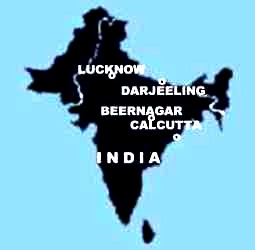 |
THE BEERNAGAR CUP
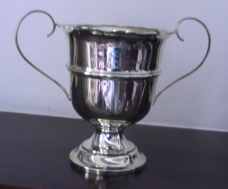 |
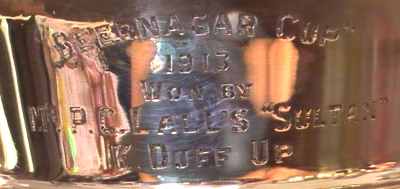
|
The Beernagar Cup, 1913
|
Cup's inscription "BEERNAGAR CUP-1913-WON BY
M.P.C.LALL'S 'SULTAN'-K.DUFF UP"
|
| |

|
| |
J.Boseck & Co, Birmingham 1912 mark
|
Beernagar is a small centre in West Bengal
and, obviously, the cup doesn't refer to a famous
horse race. Anyway the cup is elegant with simple
yet excellent workmanship. The maker is J.Boseck &
Co, possibly an Anglo-Indian firm still active in
Kolkata (India)
|
THE GOVERNOR'S CUPS
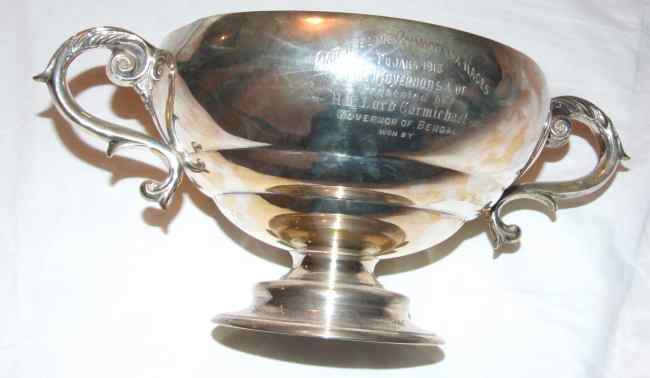 |
One of two similar 'Governor Cups' presented
in 1913 by Lord Carmichael
|
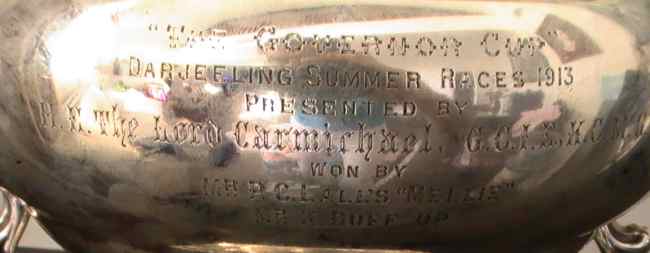 |
Cup's inscription "THE GOVERNOR
CUP-DARJEELING SUMMER RACES 1913-PRESENTED BY-
H.E. LORD CARMICHAEL G.C.I.E.K.C.M.G.-WON
BY-MR.P.C.LALL'S 'MELLIE'-MR.K.DUFF UP"
|
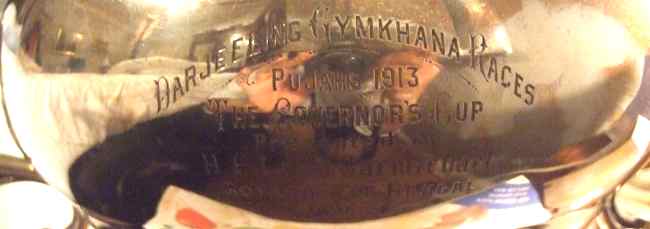 |
Cup's inscription "DARJEELING GYMKHANA
RACES-PUJAHS 1913-THE GOVERNOR'S CUP-
PRESENTED BY- H.E. LORD CARMICHAEL ....."
|
 |
Silver hallmarking on Governor's Cups: London
1912, makers The Goldsmiths & Silversmiths Co Ltd
|
Up to the point when races still took place
in Darjeeling, Bengal, foothills of the Himalayas,
some cups were presented by the British governors.
Although it is difficult to say if the same cup
design was presented more than twice, these are two
such examples of the same design. Both presented by
Lord Carmichael, in 1913, although one has his
honorary credentials after his name, whereas the
other does not.
Lord Thomas David Gibson-Carmichael (born in
Edinburgh on 18 March 1859) was the first Governor
of Bengal (1912-1917) after the annulment of the
partition of Bengal and turning it into a Governor's
province in 1912. He was in parliament representing
Middleton from 1895 to 1900, and served as the
Governor of Victoria, (in Australia, 1908-11) and
Madras (1911-12) before he became the Governor of
Bengal. He died on 16 January 1926.
The Goldsmiths & Silversmiths Co was a large
business of retail jewellers and silversmiths
established in 1880 at 112 Regent Street, London.
The original partners were William Gibson and John
Lawrence Langman. In 1898 the firm was converted
into a limited liability company under the style
of the Goldsmiths & Silversmiths Co Ltd. The firm
had many links with Indian market, participating in
the Indian and Colonial Exhibition held in South
Kensington, London in 1886 and supplying in 1921 the
extensive silver and silver-gilt dinner service made
for H.H. The Maharaja Sir Bhupendra Sing of Patiala.
In 1928 its premises were totally rebuilt and went
on to become the designated house of Garrard and Co. Ltd.,
the Crown jewellers, with whom the Goldsmiths and
Silversmiths Co. Ltd. amalgamated in 1952.
|
THE STEWARDS CUP
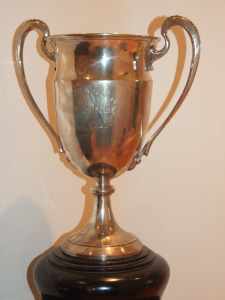 |
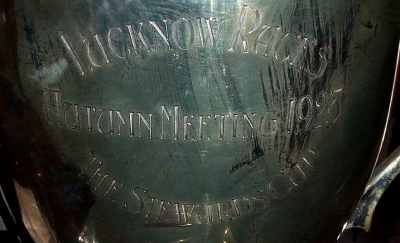
 |
The Stewards Cup, 1928
|
Cup's inscription "Lucknow Races - Autumn
Meeting 1928: The Stewards Cup" and silver hallmarks
|
The cup bears silver hallmarks for London
1928 and maker's mark is "B & F over Ltd inside an
oval", belonging to Blackmore & Fletcher Ltd. This
firm, whose directors were Ernest Blackmore and
Joseph Washington Fletcher, was listed in 1914 as
"manufacturing silversmith" at 4 Ramillies Place,
Oxford Street, London.
Lucknow is now the capital city of Uttar Pradesh,
the most populous state of India. Located in what
was historically known as the Awadh region
(anglicized to Oudh) was annexed by the East India
Company in 1856 and placed under the control of a
chief commissioner. In 1901, Lucknow was merged in
the newly formed United Provinces of Agra and Oudh
and became the provincial capital in 1920 when the
seat of government was moved from Allahabad.
Although simple in design, the size and quality of
the trophy makes it a privilege to have.
|
THE CURLENDER CUP
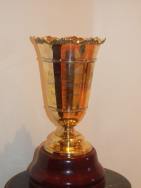 |
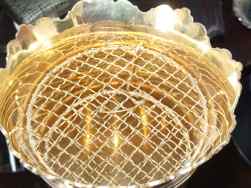 |
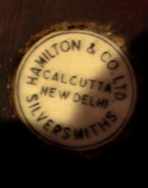 |
Calcutta Races
Curlender Cup 1955-56
|
gold washed interior
|
Hamilton & Co mark
|
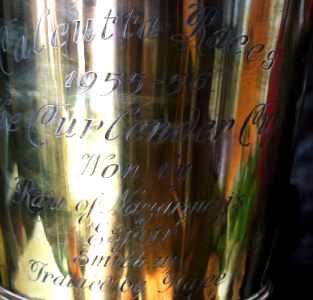 |
Cup's inscription:
"CALCUTTA RACES-1955-56-
CURLENDER CUP-RAJA OF NAZARGUNJ-
ESPOIR- SMITH UP-TRAINED BY HAJEE"
|
This is an example of a silver gold wash cup
by Hamilton & Co. Although not certain, this could
have been presented by the Curlender family, who
were amongst the affluent Jewish community in India,
also referenced in Arnold Wrights’ ‘BENGAL AND ASSAM
BEHAR AND ORISSA, Their History, People, Commerce,
and Industrial Resources’ (full text online at
http://www.archive.org/details/bengalassambehar00playuoft
)
|
THE KALINGA CUP
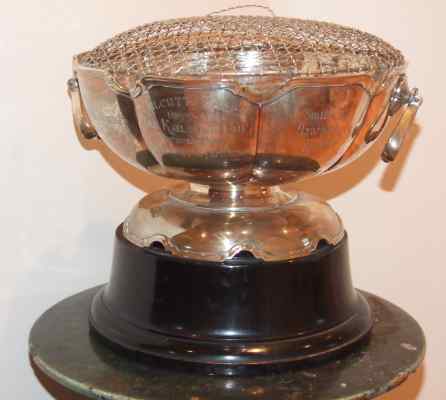 |
Calcutta Races: The Kalinga Cup 1955-1956
|
 |
Hamilton & Co mark
|
 |
Cup's inscription "CALCUTTA RACES-1955-56
THE KALINGA CUP - PRESENTED BY
THE RAJA OF PARLAKIMEDI
SMITH UP TRAINED BY HAJEE"
|
Kalinga was a kingdom in central-eastern India,
which comprised most of the modern state of Orissa, as
well as some northern areas of the bordering state of
Andhra Pradesh. It was a rich and fertile land that
extended from the river Damodar to Godavari and from Bay
of Bengal to Amarkantak range in the West (from
Wikipedia).
|
THE QUEEN ELIZABETH CUP
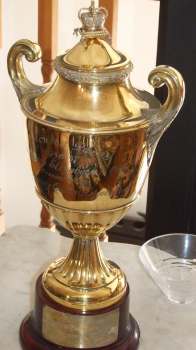 |
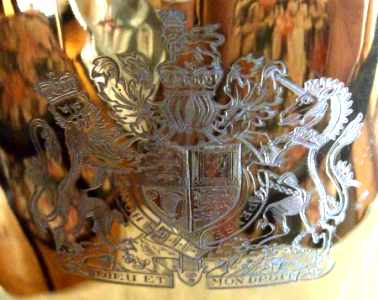
 |
Calcutta Races
The Queen Elizabeth Cup 1956-57
|
The Royal Coat of Arms of the United Kingdom
(Arms of Dominion)
and Hamilton & Co mark
|
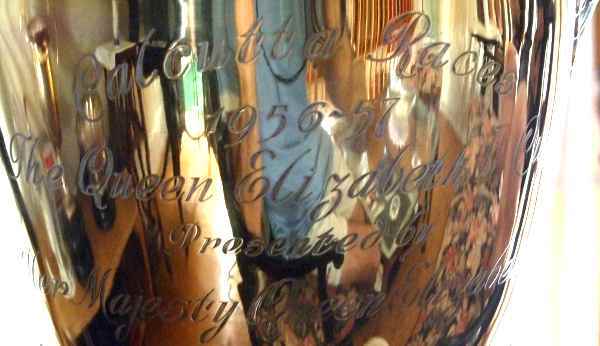 |
Cup's inscription:
"CALCUTTA RACES-1956-57-THE QUEEN ELIZABETH CUP-
PRESENTED BY-HER MAJESTY QUEEN ELIZABETH II"
|
A prize of a prestigious race, presented by
Her Majesty, Queen Elizabeth II (although not in
person). The race is still run today in India. The
size of this particular trophy is somewhat larger
than what is presented nowadays. The trophy is
silver with gold wash and was made by Hamilton & Co
|
THE CALCUTTA DERBY STAKES
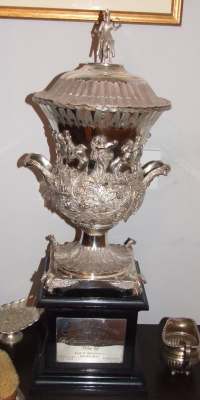 |
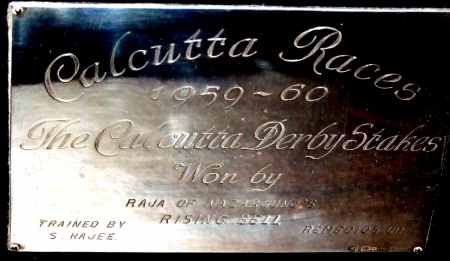 |
Calcutta Races
The Calcutta Derby Stakes
1959-60
|
Cup's inscription:
"CALCUTTA RACES-1959-60-THE CALCUTTA DERBY
STAKES-WON BY
RAJA OF NAZARGUNJ'S-RISING BELL
TRAINED BY S.NAJEE-REMEDIOS UP-
|
An ornate cup made by Hamilton & Co for the
Calcutta derby Stakes
|
THE CALCUTTA OAKS CUP
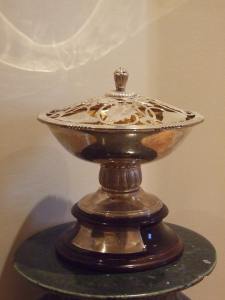 |

 |
Calcutta Races
The Calcutta Oaks Cup 1969-70
|
Cup's inscription:
"CALCUTTA RACES-1969-70-THE CALCUTTA OAKS"
and Hamilton & Co mark
|
Considered a classic race, this is a later
design of Hamilton & Co. The flower pattern on the
top is perhaps the most unique feature.
|
THE 1000 GUINEAS TROPHY
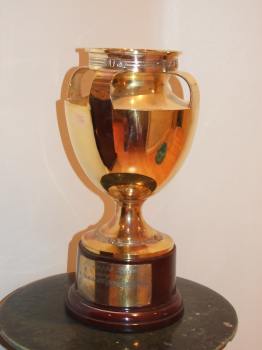 |
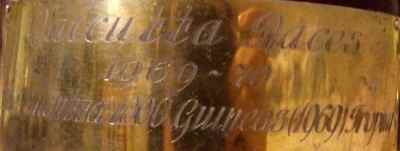
 |
Calcutta Races
The Calcutta 1000 Guineas
(1969) Trophy
|
Cup's inscription:
"CALCUTTA RACES-1969-70-CALCUTTA 1000 GUINEAS TROPHY"
and Hamilton & Co mark
|
Another classic race introduced by the
British. This trophy, made by Hamilton & Co, is
silver with gold-wash, a feature which was perhaps
fashionable at the time.
In summary, although some of the silver above
ultimately marks moments of horse racing and history
attached to it, the trophies also help tell a story,
when put together, of how styles and patterns of
silver workmanship varied and evolved through the decades.
|
|
Siddarth Chand Lall and Giorgio Busetto
- 2009 -
|
|
 ASSOCIATION OF SMALL COLLECTORS OF ANTIQUE SILVER
ASSOCIATION OF SMALL COLLECTORS OF ANTIQUE SILVER ASSOCIATION OF SMALL COLLECTORS OF ANTIQUE SILVER
ASSOCIATION OF SMALL COLLECTORS OF ANTIQUE SILVER